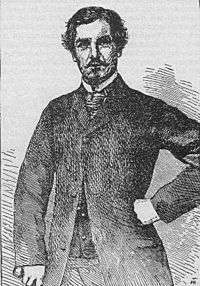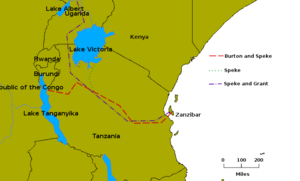James Augustus Grant facts for kids
Quick facts for kids
James Augustus Grant
|
|
|---|---|
 |
|
| Born | 11 April 1827 Nairn, Scotland
|
| Died | 11 February 1892 (aged 64) Nairn, Scotland
|
| Education | University of Aberdeen |
| Occupation | Explorer, author, armed forces officer |
| Awards | CB, CSI, FRS, FRGS |
| Military career | |
| Allegiance | |
| Service/ |
Bengal Army |
| Years of service | 1848–1868 |
| Rank | Lieutenant-colonel |
| Battles/wars | Sikh War Indian Mutiny 1868 Expedition to Abyssinia |
Lieutenant-Colonel James Augustus Grant CB CSI FRS FRGS (born April 11, 1827 – died February 11, 1892) was a Scottish explorer. He is famous for his journeys in eastern equatorial Africa. He wrote about plants and nature, especially in his work "Botany of the Speke and Grant Expedition."
Grant married in 1865 and lived in Nairn, Scotland, where he passed away in 1892. He was buried in St Paul's Cathedral. A type of gazelle, called Grant's gazelle, was named after him. It is one of the largest and most beautiful gazelles in Africa.
Contents
Early Life and Military Career
James Augustus Grant was born in Nairn, a town in the Scottish Highlands. His father was a minister in the local church. Grant went to school at Nairn Academy, Aberdeen Grammar School, and Marischal College in Aberdeen.
In 1846, he joined the Indian army. He fought in the Second Anglo-Sikh War from 1848 to 1849. He also served during the Indian Rebellion of 1857, where he was injured while helping to relieve Lucknow.
Exploring Africa: The Nile Expedition
After his military service, Grant returned to England in 1858. In 1860, he joined John Hanning Speke on a very important expedition. Their goal was to find the source of the Nile River.
The expedition started in Zanzibar in October 1860. They traveled for over two years, reaching Gondokoro in February 1863. Speke was the leader of this journey. However, Grant also did his own research. He collected many valuable plant samples. He always supported Speke throughout their adventure.
A Walk Across Africa
In 1864, Grant published a book called A Walk across Africa. This book added to Speke's story of their journey. In his book, Grant focused on the daily lives of the local people they met. He also wrote about the useful resources in the lands they explored.
For his contributions to the expedition, Grant received special honors. In 1864, he was given the Patron's Medal from the Royal Geographical Society. In 1866, he became a Companion of the Order of the Bath.
Grant also worked in the intelligence department during the Abyssinian expedition in 1868. For this service, he received the Order of the Star of India and the Abyssinian War Medal. After this war, he retired from the army as a lieutenant-colonel.
Grant's Illness During the Expedition

During the expedition, James Grant became very ill. This happened in December 1861 when they reached the kingdom of Karague, near Lake Victoria.
Grant described his illness in his book. His right leg became very swollen and painful. He had deep cuts and pus formed for months. His knee became stiff and bent, making it impossible to walk. Local people tried many cures to help him. They used poultices made of cow-dung and mud. One person even suggested a serpent had spat on his leg!
A local healer used a penknife to make small cuts on his skin. Then, a black paste made from a plantain-leaf was rubbed into the cuts. A small piece of lava was tied to his ankle as a charm. None of these cures seemed to work immediately.
By March 1862, Grant started to feel a bit better. He hoped to join Speke in Buganda, Uganda. The king of Buganda sent men to carry him. On April 14, 1862, Grant was placed in a wicker stretcher. Four men carried him on their heads. The journey was very bumpy and painful for his leg.
Eventually, the stretcher was no longer needed. The men saw that Grant was only lame and had a stiff knee. By July 1862, Speke asked Grant if he could walk quickly with him. Grant was still unable to walk twenty miles a day, especially over rough ground. Because of his health, Grant could not join Speke to see the source of the White Nile from Lake Victoria.
Grant's illness is thought to be the first recorded description of Mycobacterium ulcerans infection, also known as Buruli ulcer.
Family Life
In 1865, James Grant married Margaret Thompson Laurie. She was the daughter of Andrew Laurie from Edinburgh. They had two sons who also became involved in Africa. One son, James Augustus Grant, became a surveyor and explorer. Their other son, Alister Grant, died in the Second Boer War in 1900.
They also had three daughters named Mary, Christian, and Margaret.
See also
 In Spanish: James Augustus Grant para niños
In Spanish: James Augustus Grant para niños


